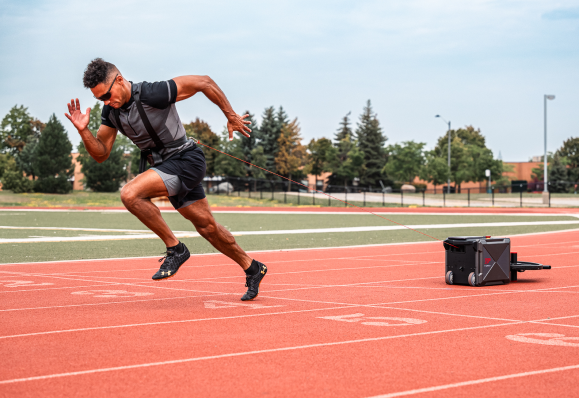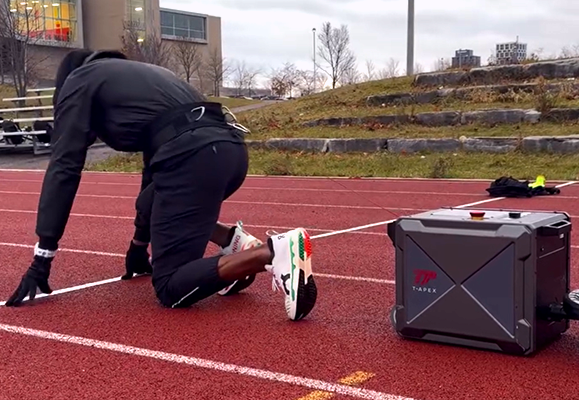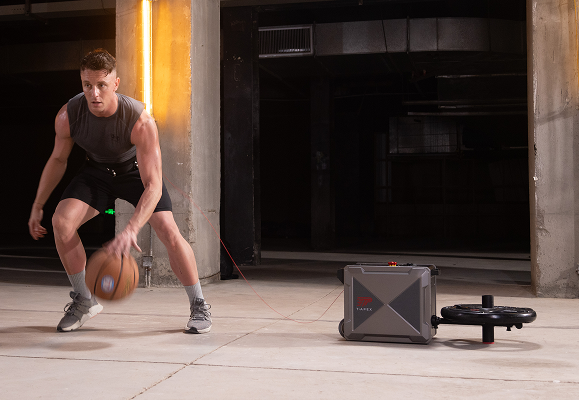What is Overspeed Training?
Overspeed Training is a technique that assists athletes in exceeding their natural maximum speed, exposing their neuromuscular system to supramaximal velocities. This method enhances stride frequency, refines running mechanics, and improves high-speed efficiency. Commonly used in track & field, swimming, and football, it boosts neuromuscular coordination, breaks psychological barriers, and complements traditional resisted sprint training.
How to Use T-APEX for Overspeed Training
T-APEX is a leading-edge training device designed to support both resisted and assisted speed training. With its Overspeed Mode, athletes and coaches can design customized overspeed sessions with precise force and velocity control. Let’s break down how to maximize Overspeed Mode using T-APEX.

-
Assistance:The maximum assistance force during the session.
-
Assistance Range: 0 – 15 kg(preset to 15 kgf)
-
Start Recommendation: 8 kgf
-
Progressive Adjustment: Increase by 1 kgf based on athlete response
This allows you to choose how much force is used to tow the athlete forward. Beginners should start with lighter assistance and gradually increase as adaptation occurs.
-
Recspeed:The maximum towing speed during the session.
-
For Sprinters: Install the overspeed add-on to boost towing speed to 14 m/s.
-
For Swimmers/Other Lower-speed Sports: Set a standard speed range of 0 – 7 m/s.
-
Suggested Start Point: No more than 20% above your top speed tested in Normal Mode (use 1–2 kg of resistance for testing)
Establish a baseline sprint under Normal Mode, then set your maximum towing speed accordingly. This helps create a safe yet challenging overspeed stimulus.
-
Advanced Control – Progressive Speed Zones
In Overspeed Mode, T-APEX offers an advanced control interface where you can:
-
Divide a run into up to 10 distance-based segments
-
Customize the velocity for each segment
For example, a user could set speed increments like this:
-
0–10m: 9.3 m/s
-
10–20m: 9.5 m/s
-
20–30m: 9.7 m/s
-
… up to 10.1 m/s
This gradual progression:
-
Helps athletes adapt throughout the rep
-
Reduces injury risk from sudden acceleration
-
Improves the athlete’s ability to maintain better form under continuous acceleration
Step-by-Step Overspeed Setup in T-APEX:
-
Choose Overspeed Mode in the T-APEX App
-
Set Assistance Force (begin at 8 kgf if new)
-
Set Recspeed target – ensure it is within safe margin
-
Navigate to Advanced Control
-
Define your ChangeV Distance and ChangeV Value points
-
Begin training and monitor athlete response

Who Can Benefit from Overspeed Training?
Overspeed Training isn’t just for sprinters. It benefits a wide range of speed-based sports.
Applicable Sports:
-
Track & Field (Sprints and Hurdles)
-
Football / Soccer (Acceleration and Top Speed)
-
American Football (WRs, DBs)
-
Swimming (Power off the walls, Stroke tempo)
-
Basketball (First step quickness)
-
Baseball and Softball (Base stealing, fielding speed)
-
Rugby and Lacrosse (Field coverage speed)
-
Speed Skating and Winter Sports (Straight-line velocity)
Training Program Example:
Here’s a basic sample workout using T-APEX Overspeed Mode for a sprinter:
Objective: Progressive overspeed sprint to reach 10.1 m/s over 40m
-
Total Reps: 4-6
-
Recovery: Full between reps (3–4 min)
-
Setup:
-
Assistance: 10 kgf
-
Recspeed Max: 10.1 m/s
-
Speed Zones:
-
0–10m @ 9.3 m/s
-
10–20m @ 9.5 m/s
-
20–30m @ 9.7 m/s
-
30–40m @ 10.1 m/s
-
-
Suggestions:
-
Start Overspeed block only when athlete is well-rested
-
Combine with resisted runs and technical sprint drills for balanced development
-
Use video feedback to monitor sprint mechanics at high speed
Final Thoughts
Overspeed Training pushes the boundaries of what the athlete thinks is possible—and with T-APEX, you have the tools to do it safely, progressively, and precisely. From customizable speed curves to adjustable assistance force, the T-APEX Overspeed Mode is the gold standard for athletes looking to take their speed to the next level.
Ready to rewire your nervous system for speed?


